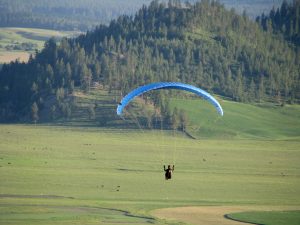Bolting straight down a mountain slope and off a cliff, my world is now spinning and a Cheshire Cat grin not-so-slowly broadens across my face. It’s time to collect wits and embrace the task at hand. Sunlight periodically reflects off the face of my Flytec 5030, giving a timing to my 360s. I steepen the bank of my Wills Wing U2-160 to stay within the core of a thermal triggered and/or spawned by the town of Valley, Wash. It’s 11:30 a.m. on March 28, and I’m climbing at over 500 feet a minute with a red-tailed hawk up through 6,000 feet.
Hang gliding for me is an alluring, controlled addiction – or so I tell myself. I’m not alone. There are roughly two-to-three dozen of us afflicted souls who have bonded into a United States Hang Gliding and Paragliding Association Chapter based in Spokane named Center Of Lift. We are often above you, silently striving to reach cloudbase via footlaunching our craft off hills, mountains and cliffs (occasionally towing up with quite a technical array of gear). So far this year (I’m finishing this story in early May), one of our members has already footlaunched from Tekoa Mountain and landed at the Boundary County Airport outside of Bonners Ferry – a straight-line distance exceeding 100 miles.

On this last Saturday in March, I launched at 10 a.m. to explore the morning atmosphere from Inkler’s Point, a ridge jutting out into the Colville River Valley six miles south of Chewelah, Wash. Chances are that morning flying seldom produces the lift I’m in. At 6,300 feet over the “This Pond For Sale” sign along Highway 395, I exit my up elevator and head back to Inkler’s Point, making a feather-light landing right at noon along Highway 231. The Cheshire Cat grin comes back.
It is really amazing to me that more people are not involved in hang gliding and paragliding in the Inland Northwest. I suppose it has something to do with out-of-sight, out-of-mind. And our sports are not easy ones to learn. A person has to be more or less smitten with the idea of flying with hawks and eagles and be incredibly patient to wait for ideal weather conditions for learning. It also requires setting aside the time to learn – a learning that never ceases, only grows.

For all practical purposes, we operate in an invisible medium that is initially quite foreign to us Earthlings. It takes time and perseverance to become a Skyling – even if only for the few minutes or hours that we are aloft. Yet it is exceedingly gratifying to be able to take oneself and one’s gear thousands of feet into the air with only acquired knowledge and skills. Our sports are more cerebral than exerting – in short, roughly 90% mental and 10% physical. The mental portion being mostly devoted to decision making based upon knowledge of how our atmosphere behaves coupled with a realistic assessment of our own skills. We fly to fly another day. Compounding risks is just plain counter-productive (or worse).
Got your interest? Want to learn more? Check out our website: Centeroflift.org. There you’ll find a host of links to further information, including links to a few of our members’ YouTube channels. GoPros are an accessory of ours that are acquired sooner or later (usually sooner). Gliders can range in price from under $1,000 used to over $20,000 for new rigid wing craft. I currently fly an intermediate-to-advanced hang glider that is $5,500 new (I bought mine used for under $2,000). My other gear, including a harness, helmet, 2-way radios, fight instruments, GoPro, emergency parachute and a host of smaller items likely cost me $4,000 (most of it new). Is it worth it? That Cheshire Cat grin is back again!
Want to learn to Hang Glide or Paraglide?
You won’t have to travel far to learn from experienced instructors right here in the Inland Northwest. For lessons or info on tandem flights, contact USHPA hand gliding instructor Dale Sanderson at 509-981-8602. For paragliding, contact USHPA instructor Robert Hecker at 208-651-4423 or [email protected]. You can also check out Northwest Free Flight on Facebook for more local paragliding info. // (Steve Baran)













